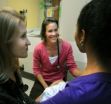(Press-News.org) Analysis of specific biomarkers in a cerebrospinal fluid sample can differentiate patients with Alzheimer's disease from those with other types of dementia. The method, which is being studied by researchers at Sahlgrenska Academy, may eventually permit earlier detection of Alzheimer's disease.
Due to the similarity of the symptoms, differentiating patients with Alzheimer's from those with other types of dementia – or patients with Parkinsondisease from those with other motor disorders – is often difficult.
Making a proper diagnosis is essential if proper treatment and medication are to commence at an early stage. A research team at Sahlgrenska Academy, University of Gothenburg, is developing a new method to differentiate patients with Alzheimer's disease or Parkinson disease by analyzing a cerebrospinal fluid sample.
The study, led by Professor Kaj Blennow and conducted among 450 patients at Skåne University Hospital and Sahlgrenska University Hospital, involved testing five proteins that serve as biomarkers for the two diseases.
"Previous studies have shown that Alzheimer's disease is associated with biochemical changes in specific proteins of the brain," says Annika Öhrfelt, a researcher at Sahlgrenska Academy. "This study has found that the inclusion of a new protein can differentiate patients with Alzheimer's disease from those with Lewy body dementia, Parkinson disease dementia and other types of dementia."
Similarly, the biomarkers can differentiate patients with Parkinson disease from those with atypical Parkinsonian disorders.
"Additional studies are needed before the biomarkers can be used in clinical practice during the early stages of disease," says Öhrfelt, "but these results represent an important step along the way."
### The article, entitled "Accuracy of a Panel of 5 Cerebrospinal Fluid Biomarkers in the Differential Diagnosis of Patients with Dementia and/or Parkinsonian Disorders," was published by the Journal of the American Medical Association.
Link to paper: http://bit.ly/UH3TVd
Contact:
Annika Öhrfelt, Researcher at Sahlgrenska Academy
Cell: +46 734-25 74 99
Landline: +46 31 343 24 06
FACTS ABOUT THE STUDY
The study analyzed the following proteins: beta-amyloid, tau (P-tau), alpha-synuclein and neurofilaments. Participating researchers from the University of Gothenburg: Annika Öhrfelt, Radu Constantinescu, Ulf Andreasson, Björn Holmberg, Henrik Zetterberg and Kaj Blennow.
Biomarkers in cerebrospinal fluid can identify patients with Alzheimer's disease
2012-10-22
ELSE PRESS RELEASES FROM THIS DATE:
Climate change threatens marine environment in the Baltic Sea
2012-10-22
At the end of the 21st century, the temperature in the Baltic Sea will be higher and the salt content lower than at any time since 1850. If no action is taken to alleviate the effects of climate change, there may be major consequences for the marine environment.
"This is the first time that anyone has taken a detailed look at how climate models and individual factors combine to affect a specific region. This makes this project unique," says Jonathan Havenhand from the Department of Biological and Environmental Sciences at the University of Gothenburg, Sweden.
A large ...
Aspirin may slow the decline in mental capacity among elderly patients
2012-10-22
A daily dose of acetylsalicylic acid equivalent to a fourth of an aspirin may slow the decline in intellectual capacity among elderly individuals with high cardiovascular risk.
This is shown in a study by Sahlgrenska Academy, University of Gothenburg, Sweden.
Researchers at Sahlgrenska Academy, University of Gothenburg, over a five year period studied how intellectual capacity changes among 681 elderly women (70 to 92 years) with heightened risk of suffering from a heart attack, vascular spasm or stroke.
Of the 681 women, 129 received a low daily dose of acetylsalicylic ...
The hidden threat posed by inconspicuous stripes
2012-10-22
Patterns fascinate. Particularly stripes. Found in nature in zebras, they are also found in the most unlikely places, such as powdered drugs' mixing vessel walls. In an article about to be published in EPJ E, Nirmal Thyagu and his colleagues from Rutgers University, New Jersey, USA, propose a traffic model to predict the formation of different patterns, ranging from stripes to spots.
Thanks to simulations, Thyagu and colleagues showed the underlying stripe formation mechanism, which they propose stems from traffic-like jams, whereby particles move more slowly when surrounded ...
Saving time, saving lives
2012-10-22
Istanbul, 22 October 2012: Experts in emergency cardiac care from around the world met in Istanbul to discuss ways to improve outcomes in patients with acute cardiac disease. This was the first annual meeting of the newly launched Acute Cardiovascular Care Association (ACCA) of the European Society of Cardiology (ESC) (1). The congress concludes today.
"The key message is that time saves lives," said Professor Tom Quinn, United Kingdom, member of the ACCA Board. "In cardiac emergencies, such as a heart attack, calling an ambulance immediately ensures the patient gets ...
Immune cells of the blood might replace dysfunctional brain cells
2012-10-22
This press release is available in German.
The immune system is comprised of multiple cell types each capable of specialized functions to protect the body from invading pathogens and promote tissue repair after injury. One cell type, known as monocytes, circulates throughout the organism in the blood and enters tissues to actively phagocytose (eat!) foreign cells and assist in tissue healing. While monocytes can freely enter most bodily tissues, the healthy, normal brain is different as it is sequestered from circulating blood by a tight network of cells known as the ...
Mock clinical exams boost pediatric residents' comfort in addressing breastfeeding
2012-10-22
AUGUSTA, Ga. – A simulated clinical experience guiding future pediatricians through interactions with breastfeeding moms appears to put the doctors at ease with the sensitive and important health topic, researchers say.
"We showed that their confidence and comfort increased with the OSCE (Objective Structured Clinical Examination) interventions," said Dr. Kathryn McLeod, a pediatrician and educator at the Medical College of Georgia at Georgia Health Sciences University who developed the three simulated patient exams.
Breastfeeding education typically falls to pediatricians ...
Gastric bypass surgery just as effective in teenagers as in adults
2012-10-22
Teenagers with severe obesity can benefit from gastric bypass surgery just as much as adults. A study by Sahlgrenska Academy, University of Gothenburg, Sweden and Karolinska Institutet, Sweden found that 81 teenagers lost an average of 96.8 pounds following surgery, significantly improving their health and quality of life.
The study, published by the International Journal of Obesity, involved eighty-one 13-18 year-olds who had gastric bypass surgery, which had previously been performed on people younger than 18 in exceptional cases only.
The new study found that gastric ...
Want the shortest path to the good life? Try cynicism
2012-10-22
Are cynics and happiness mutually exclusive? For modern cynics, perhaps. But for the ancient Cynics, not necessarily.
Research by the University of Cincinnati's Susan Prince shows that despite the historical perception of the ancient Cynics as harsh, street-corner prophets relentlessly condemning all passersby and decrying society's lack of virtue, these Greek philosophers, indirectly descended from Socratic teaching, weren't all doom and gloom. They actually might have espoused a shortcut to happiness.
"We don't have good scholarship on the Cynics. They're seen as ...
Rejecting arsentate
2012-10-22
Not long ago, some unassuming bacteria found themselves at the center of a scientific controversy: A group claimed that these microorganisms, which live in an environment that is rich in the arsenic-based compound arsenate, could take up that arsenate and use it – instead of the phosphate that all known life on Earth depends on. The claim, since disproved, raised another question: How do organisms living with arsenate pick and choose the right substance?
Chemically, arsenate is nearly indistinguishable from phosphate. Prof. Dan Tawfik of the Biological Chemistry Department ...
3D structure of an unmodified G protein-coupled receptor in its natural habitat
2012-10-22
Scientists have determined the three-dimensional structure of a complete, unmodified G-protein-coupled receptor in its native environment: embedded in a membrane in physiological conditions.
Using NMR spectroscopy, the team mapped the arrangement of atoms in a protein called CXCR1, which detects the inflammatory signal interleukin 8 and, through a G protein located inside the cell, triggers a cascade of events that can mobilize immune cells, for example.
Because G protein-coupled receptors are critical for many cellular responses to external signals, they have been ...

